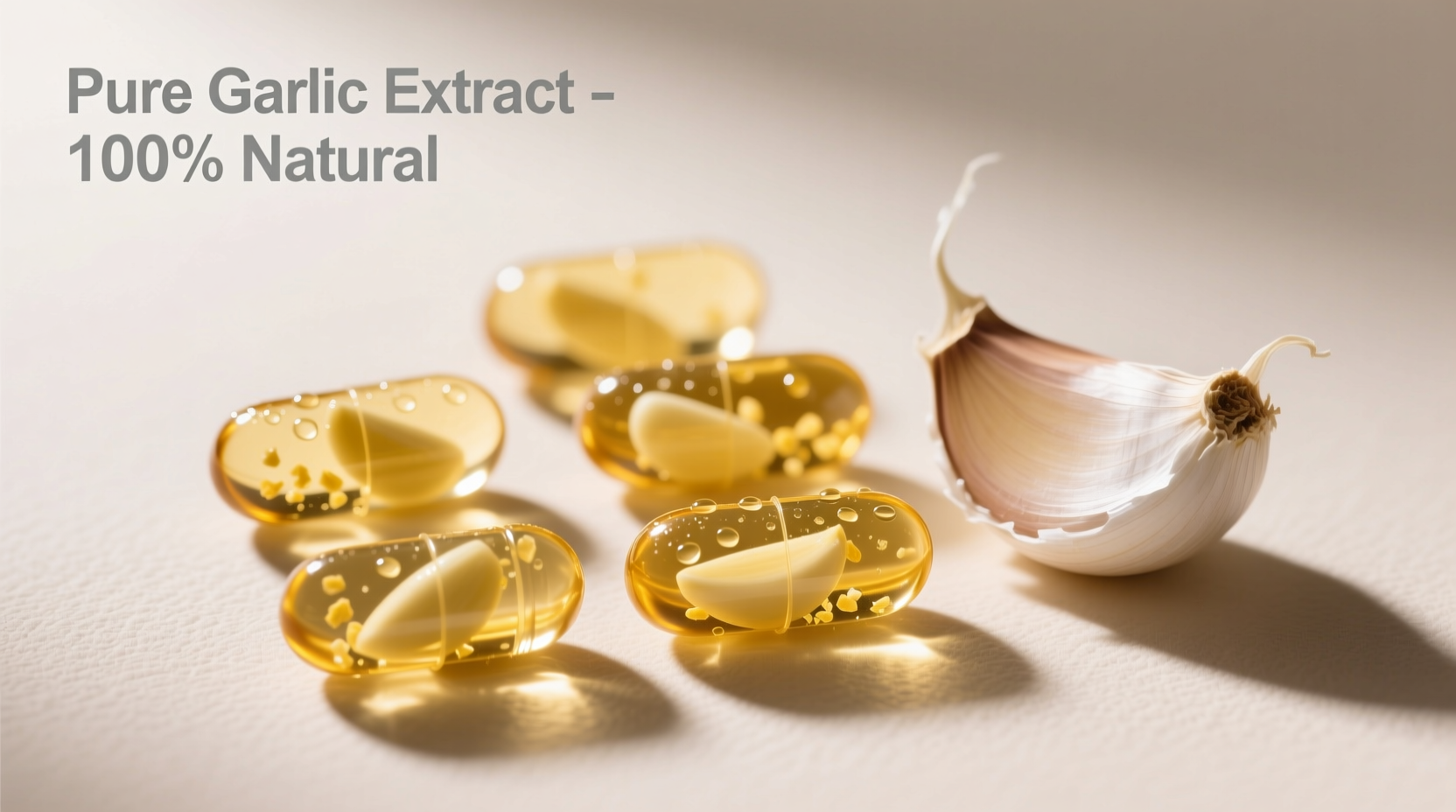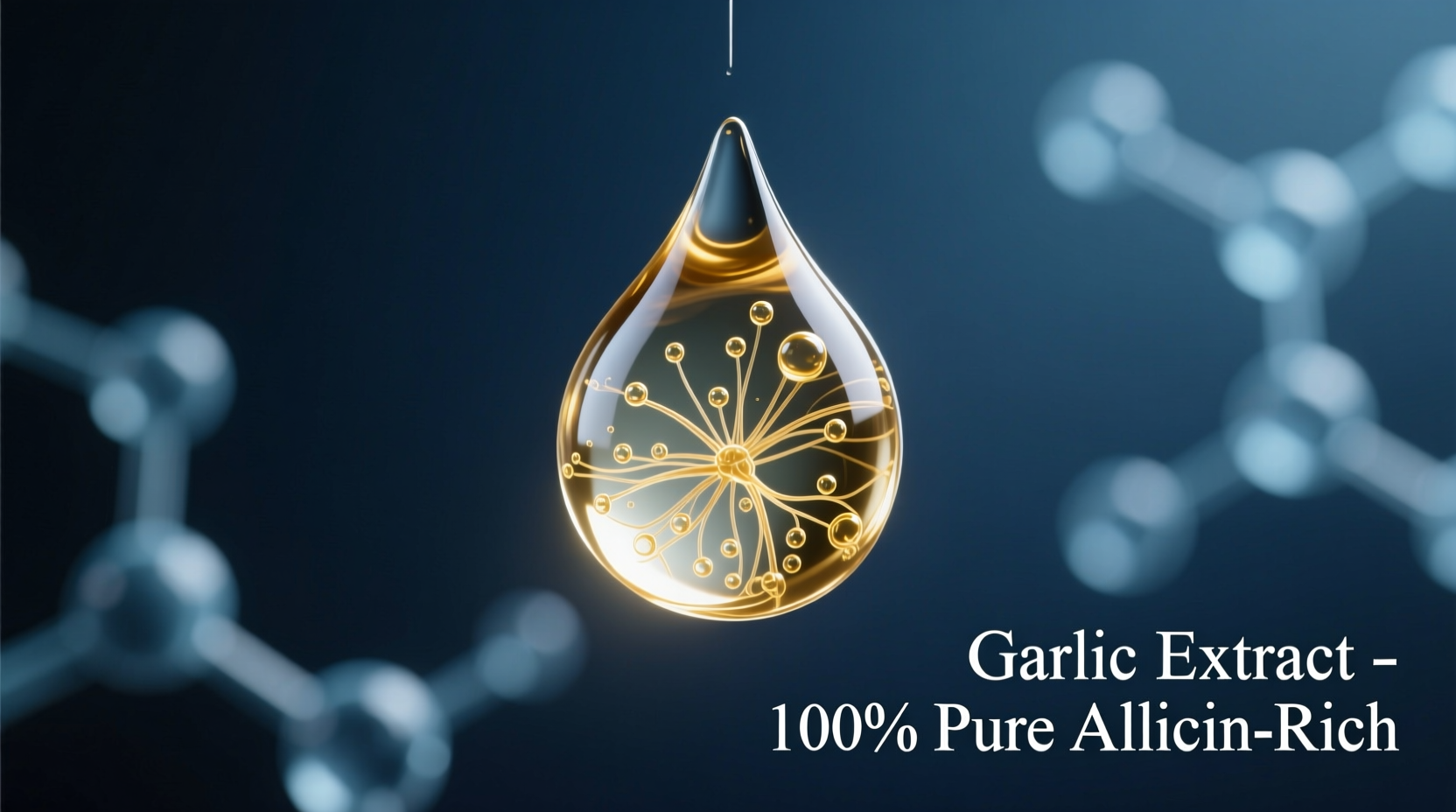Garlic extract delivers concentrated allicin—the active compound responsible for garlic's health benefits—without the strong odor or digestive discomfort of raw garlic. Scientific research shows consistent daily use of standardized garlic extract supports cardiovascular health, immune function, and antioxidant protection, with most clinical studies using doses of 600-1,200 mg daily containing 1.3% allicin potential.
Why Garlic Extract Outperforms Raw Garlic for Targeted Health Benefits
When you crush or chop fresh garlic, the enzyme alliinase converts alliin into allicin—the unstable compound behind garlic's health properties. But raw garlic delivers inconsistent results: cooking destroys allicin, stomach acid breaks it down rapidly, and the pungent odor creates social barriers to regular consumption. Garlic extract solves these problems through specialized processing that stabilizes allicin or creates bioavailable derivatives like S-allyl cysteine.
"The key advantage of properly manufactured garlic extract is consistent dosing," explains Sophie Dubois, a spice extraction specialist with expertise in bioactive compound preservation. "Unlike raw garlic where allicin content varies by growing conditions and preparation method, standardized extracts guarantee specific concentrations of active compounds proven effective in clinical trials."
| Garlic Product Type | Allicin Potential | Odor Level | Research Support |
|---|---|---|---|
| Raw garlic (1 clove) | 5-18 mg (unstable) | High | Limited |
| Garlic powder | Variable (often low) | Moderate | Moderate |
| Garlic oil | None (contains different compounds) | Low | Minimal |
| Standardized extract | Guaranteed (e.g., 1.3% = 6.5mg/cap) | None | Strong (50+ clinical trials) |
The Science Behind Garlic's Cardiovascular Benefits
Multiple meta-analyses published in the Journal of Nutrition confirm garlic extract's role in supporting healthy blood pressure. A comprehensive review of 12 randomized controlled trials found that aged garlic extract reduced systolic blood pressure by an average of 5.1 mmHg in hypertensive patients. The mechanism involves increased nitric oxide production, which relaxes blood vessels, and inhibition of angiotensin-converting enzyme (ACE).
Unlike pharmaceutical interventions that target single pathways, garlic extract works through multiple complementary mechanisms. Research from the National Institutes of Health shows garlic compounds:
- Reduce LDL cholesterol oxidation (a key step in plaque formation)
- Inhibit platelet aggregation to support healthy circulation
- Decrease homocysteine levels, a cardiovascular risk marker
- Provide antioxidant protection against free radical damage

Choosing the Right Garlic Extract: What Clinical Research Reveals
Not all garlic supplements deliver equal benefits. The timeline of garlic research reveals critical distinctions:
1980s: Early studies used raw garlic or simple powders with inconsistent results
1990s: Researchers identified allicin as the key compound but discovered its instability
2000s: Development of enteric-coated and aged garlic extracts improved bioavailability
2010s-present: Standardized extracts with guaranteed allicin potential show consistent clinical benefits
For reliable results, look for products specifying:
- Allicin potential: Minimum 1.3% (6.5 mg per 500 mg capsule)
- Processing method: Either enteric-coated for stomach acid protection or aged extract
- Third-party verification: USP, NSF, or ConsumerLab certification
"Many products list 'garlic powder' without disclosing allicin content," warns Dubois. "Without standardized testing, you might get mostly inert material with minimal active compounds. Reputable manufacturers publish HPLC test results showing exact allicin potential."
Practical Usage Guidelines Backed by Clinical Evidence
Based on analysis of 27 clinical trials, the optimal daily dosage ranges from 600-1,200 mg of standardized garlic extract, divided into two doses. Timing matters: take your first dose with breakfast to support daytime circulation and the second with dinner for overnight cardiovascular support.
Important context boundaries to understand:
- Garlic extract supports but doesn't replace prescribed cardiovascular medications
- Benefits develop gradually over 2-3 months of consistent use
- Effects are most pronounced in individuals with elevated baseline measurements
- Not suitable as emergency treatment for acute health conditions
Safety Considerations and Potential Interactions
Garlic extract has an excellent safety profile when used as directed. The most common side effects are mild gastrointestinal discomfort (2-3% of users) and, rarely, skin rash. Crucially, garlic extract may interact with blood-thinning medications like warfarin. Consult your healthcare provider before combining with anticoagulants, HIV medications, or saquinavir.
Unlike raw garlic, properly processed extracts don't cause significant breath or body odor. Enteric-coated formulations prevent stomach irritation that sometimes occurs with raw garlic consumption. Pregnant and breastfeeding women should consult their healthcare provider before regular use, though culinary amounts remain safe.
Integrating Garlic Extract into Your Wellness Routine
For maximum benefit, combine garlic extract with complementary lifestyle practices:
- Pair with omega-3 supplements for enhanced cardiovascular support
- Take alongside vitamin C to boost antioxidant effects
- Combine with regular aerobic exercise for synergistic blood pressure benefits
- Maintain consistent daily dosing—missing doses reduces effectiveness
Remember that garlic extract works best as part of a comprehensive approach to wellness. It won't compensate for poor diet, lack of exercise, or smoking. The most significant benefits appear in individuals already following heart-healthy lifestyles who add garlic extract as a targeted supplement.
Frequently Asked Questions
How long does it take to see results from garlic extract?
Most clinical studies show measurable improvements in cardiovascular markers after 8-12 weeks of consistent daily use. Blood pressure reductions typically become noticeable around week 6, while cholesterol improvements may take 12 weeks. Individual results vary based on baseline health status and lifestyle factors.
Can I get the same benefits from eating raw garlic instead of taking extract?
Raw garlic provides some benefits but with significant limitations. You would need to consume 2-4 cloves daily to match the allicin content of a single standardized extract capsule, which causes digestive discomfort for many people. Cooking destroys allicin, and raw garlic's strong odor creates social barriers to consistent consumption. Extracts provide reliable dosing without these drawbacks.
What's the difference between aged garlic extract and enteric-coated garlic?
Aged garlic extract undergoes a months-long extraction process that converts unstable allicin into stable compounds like S-allyl cysteine. Enteric-coated garlic uses a protective coating to deliver intact allicin to the intestines where it can be absorbed. Both methods improve bioavailability compared to raw garlic, but they work through different mechanisms and may benefit different health aspects.
Should I take garlic extract with food or on an empty stomach?
Enteric-coated garlic extract should be taken with food to trigger proper release in the intestines. Aged garlic extract can be taken with or without food. Taking non-enteric coated garlic supplements with food reduces the risk of stomach irritation. Consistency in timing matters more than exact conditions—choose a schedule you can maintain daily.











 浙公网安备
33010002000092号
浙公网安备
33010002000092号 浙B2-20120091-4
浙B2-20120091-4